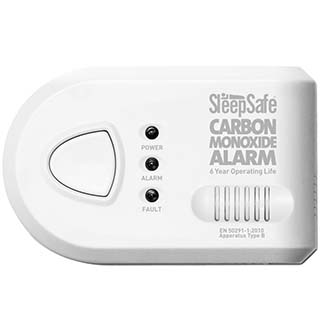The simple answer is yes, you can get carbon monoxide from a wood-burning stove. However, carbon monoxide poisoning is also possible with additional fuels such as gas, oil, solid minerals and biomass. Not just wood-burning and multifuel stoves. So, how can you protect yourself against carbon monoxide poisoning?

It is only faulty or badly maintained equipment which will put you at danger of carbon monoxide poisoning. Therefore, there are a number of actions you can take to protect yourself.
Installing your stove
In theory anyone can install a stove as long as it is signed off by the local authority building department. In practice many people choose to use an approved fitter who can install your stove without additional paperwork. Initially, this is the best way to protect you from faulty/badly installed stoves.
Carbon monoxide alarms
For many years now carbon monoxide alarms have been deemed a legal requirement with the installation of any wood-burning/multifuel stove. This ensures that in the event of fault or damage to your stove, any carbon monoxide leaks will be detected and an alarm sound.
Regular maintenance of your stove
It is essential to carry out regular maintenance of your stove and flue, preferably by qualified personnel, to avoid carbon monoxide poisoning. This ensures that not only is your stove cleaned, and repairs carried out, but your flue and chimney are swept on a regular basis. This will also improve the efficiency of your stove.
Use quality fuel
Various types of fuel in different environments do have the potential to induce carbon monoxide poisoning. It is therefore vital that you use the best fuel for your wood-burning/multifuel stove and ensure it is dried to the perfect level (no more than 20% moisture). When burning wood covered in paint, as one example, this can also create other potentially harmful fumes.
In summary, ensure your full stove is fitted by a qualified installer and regular maintenance is carried out. We will now take a look at some of the more common symptoms associated with carbon monoxide poisoning. These include:-
• Headaches
• Nausea
• Vomiting
• Dizziness
• Breathlessness
• Chest pains
• Stomach pains
• Impaired vision
Those who have looked into carbon monoxide poisoning will be well aware this is an odourless, colourless and tasteless gas. In many ways these characteristics are unique making it extremely dangerous.

Conclusion
Carbon monoxide is not known as the “silent killer” for nothing. It is an extremely dangerous gas which is odourless, colourless and tasteless. Those who persist in cutting corners with regards to stove installations, quality of fuel and regular maintenance may potentially put themselves at risk. Over the last 20 years the authorities have tightened regulations regarding stoves with carbon monoxide alarms now a legal obligation with every installation. However, this has not stopped a small minority from cutting corners and cutting costs.
It is worth reminding ourselves that carbon monoxide deaths have fallen dramatically over the years. There is still a need to be vigilant and not just with those using wood-burning/multifuel stoves. The good news, installations by a qualified fitter, regular maintenance and the use of quality fuel will ensure your safety.

